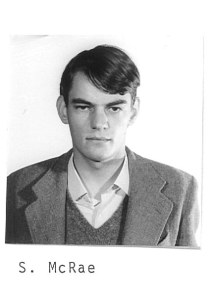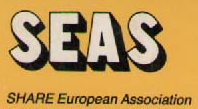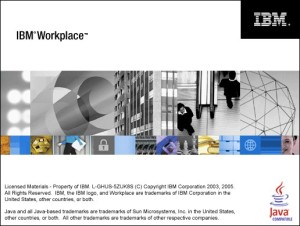 In 1973 I arrived at Imperial College, London, as part of their first ever Computer Science undergraduate intake. I soon discovered a couple of departmental teletypes connected to the university CDC 6400 that I could use to send messages to other users of the mainframe.
In 1973 I arrived at Imperial College, London, as part of their first ever Computer Science undergraduate intake. I soon discovered a couple of departmental teletypes connected to the university CDC 6400 that I could use to send messages to other users of the mainframe.
The following year the department acquired an IBM 370 model 135 mainframe for its own use, and I spent my evenings helping the staff set up VM/370 (thus kick starting a systems programming career). It had a built in email application, which would soon be extended to (via RSCS) to enable networked mail between mainframes and around the world.
 After graduating, I stayed on at Imperial to support the use of the mainframe for teaching, and got involved with the VM User Group in the UK, SEAS in Europe and SHARE in the US – IBM user associations that helped me to understand Enterprise IT and build a personal network of contacts inside and outside of IBM. By the end of the 70s, we had dial up access to a mainframe in the US running VMShare, a group collaboration system accessed by companies and universities around the world – not dissimilar in capability to the bulletin boards of the 90s and what Facebook then Slack deliver in this century.
After graduating, I stayed on at Imperial to support the use of the mainframe for teaching, and got involved with the VM User Group in the UK, SEAS in Europe and SHARE in the US – IBM user associations that helped me to understand Enterprise IT and build a personal network of contacts inside and outside of IBM. By the end of the 70s, we had dial up access to a mainframe in the US running VMShare, a group collaboration system accessed by companies and universities around the world – not dissimilar in capability to the bulletin boards of the 90s and what Facebook then Slack deliver in this century.
Through my network of contacts, in 1983 I joined a UK startup in Reading, UK, called Systell (later renamed Systems & Telecoms), as employee number eight. They had built a solution to connect the Telex machines (the global business network of the day) to Unix systems and my task (after some contract systems programming to fund purchasing an IBM 4331) was as part of a team developing a Telex Solution (VMTelex) for the IBM mainframe. Out first customer was a County Council in the UK, but it was really the oil companies with their extensive Telex networks that drove our business, and led us to an international market.
Our business got a great boost when IBM announced PROFS, the Professional Office System, running on VM, as it was the first recognisable business collaboration solution. We added Fax support to extended the business communication market (creating VMMessenger) and I became Technical Director, on the Board, and helped launch our US subsidiary. Soon we had customers around the world, and IBM became a reseller.
 Then in 1990 we sold the company to Soft•Switch, a US vendor of email interoperability software running on the mainframe (and later as a Unix appliance). As first Product Architect and then Product Manager for the integration of the product lines, I was involved in the evolution of employee collaboration from file sharing based PC email systems (like cc:Mail), to client/server groupware solutions (pioneered by Lotus Notes), and finally, with the emergence of the Internet and SMTP, email switching became redundant (though not before some of our customers were interconnecting twenty-plus different email systems and directories via Soft•Switch).
Then in 1990 we sold the company to Soft•Switch, a US vendor of email interoperability software running on the mainframe (and later as a Unix appliance). As first Product Architect and then Product Manager for the integration of the product lines, I was involved in the evolution of employee collaboration from file sharing based PC email systems (like cc:Mail), to client/server groupware solutions (pioneered by Lotus Notes), and finally, with the emergence of the Internet and SMTP, email switching became redundant (though not before some of our customers were interconnecting twenty-plus different email systems and directories via Soft•Switch).
 I continued to be focussed on enabling employee collaboration through IT after Lotus acquired Soft•Switch and then IBM acquired Lotus – ending up as the fax/telex Product Line Manager, Shortly after which, we decided that Computer Fax was no longer a growth area and shut the business down! After taking a 6 week sabbatical in the South Pacific, I returned to join the Lotus Notes Worldwide Product Management team, looking for a new emerging technology area. As a result I became responsible for Unified Communications, working closely with the emerging Mobile & Wireless solutions group. That was followed by a return to the European team to manage the technical relationship with Nokia and Ericsson around WAP and their new, emerging Smartphones.
I continued to be focussed on enabling employee collaboration through IT after Lotus acquired Soft•Switch and then IBM acquired Lotus – ending up as the fax/telex Product Line Manager, Shortly after which, we decided that Computer Fax was no longer a growth area and shut the business down! After taking a 6 week sabbatical in the South Pacific, I returned to join the Lotus Notes Worldwide Product Management team, looking for a new emerging technology area. As a result I became responsible for Unified Communications, working closely with the emerging Mobile & Wireless solutions group. That was followed by a return to the European team to manage the technical relationship with Nokia and Ericsson around WAP and their new, emerging Smartphones.
 When IBM then announced their re-imagined collaboration portfolio, IBM Workplace, it was natural for me to lead the launch in Europe. Always focussed on the emerging technology! When that ambitious initiative finally closed down, as IBM refocused its collaboration efforts on IBM Connections which fit better with the emerging enterprise social networking market, I was a founder member of the worldwide Tiger Team which was responsible for articulating the business value of this new way to work, helping clients create a business case for their use, and then working with them on technology adoption programs. What we were really doing was enabling the people side of digital transformation, though the phrase wasn’t yet being used. And that’s what I did for the last 10 years of my time with IBM.
When IBM then announced their re-imagined collaboration portfolio, IBM Workplace, it was natural for me to lead the launch in Europe. Always focussed on the emerging technology! When that ambitious initiative finally closed down, as IBM refocused its collaboration efforts on IBM Connections which fit better with the emerging enterprise social networking market, I was a founder member of the worldwide Tiger Team which was responsible for articulating the business value of this new way to work, helping clients create a business case for their use, and then working with them on technology adoption programs. What we were really doing was enabling the people side of digital transformation, though the phrase wasn’t yet being used. And that’s what I did for the last 10 years of my time with IBM.
Throughout it all, my career was often powered by my user group involvement. I ended up as Chairman of the UK VM User Group and Treasurer on the Board of SHARE Europe (as we rebranded SEAS, before merging it with GUIDE Europe to create Guide Share Europe, GSE). This continued with our heavy involvement in the Electronic Messaging Association in the US, which led to participation in the IETF, where I helped to define Internet standards and became an author of RFC 4239 for Internet Voice Messaging. It also naturally led to participation in EEMA (the European Electronic Messaging Association), where I joined the Board (and remain Vice Chair today, although over the years its focus has moved on from Messaging and Directories to the Identity Management, Trust, Privacy and Security aspects of IT).
During my time with IBM the whole collaboration world has evolved, from email to groupware to knowledge management to enterprise social networking. Meanwhile Enterprise IT struggled to evolve with it – or to cope with the move from PCs to mobile devices as the way people communicate. Technology adoption is hard. I had dinner with Dave Crocker in the late 1990’s. His name is on RFC 822, one of the core standards for Internet mail. He described how people kept saying to him how amazing it was that email had suddenly grown from nothing to dominate enterprise communications in the mid 1990s – whereas he knew that he published that standard at the start of the 1980s.
Looking back, it is interesting how external, inter-company collaboration has been both the holy grail of enterprise collaboration and at the trailing edge of technology adoption by businesses. First telex/fax, and then SMTP, were about the only solutions used until the emergence of internet-based business social networks provided a way for employees to go round the IT department and collaborate externally by themselves. As the digital revolution finally starts to change the shape and structure of enterprises – and, with Cloud, rewrite the definition of enterprise IT – it seems clear that the next generation of enterprises will have a very different attitude to how their employees collaborate.
In the words of Amara’s Law, “We tend to overestimate the effect of a technology in the short run and underestimate the effect in the long run”. I like to adapt this thought as “We tend to overestimate enterprise IT’s ability to adopt disruptive technology in the short term and underestimate the change it causes to how enterprise IT works in the long term”.
One thing is clear: change will continue. My last two external events were the ISSE conference in Brussels, where I chaired a panel on Quantum Cryptography, and the EEMA Fireside Debate on Cognitive Machine and Artificial Intelligence, where I led a discussion about the impact of AI on the world of work.
Today I retire from IBM. Reflecting on my career it has been all about the sue of different emerging technologies to improve the way employees work: helping them collaborate, network and influence; and helping the organisation they work for to optimise their processes, motivate their staff, align their activities and gain insight from their conversations.
During those 34 years since I joined that startup in Reading I have been trying to help employees to work together when they are not physically together (separated by time and distance). It’s been quite a journey, from Teletypes & Telex to Quantum Computing & Artificial Intelligence. But its always been about people – who are at the heart of any organisation – and the way they use technology to do their jobs.


All the best, Stuart. Keep in touch!
Awesome read Stuart ! I’m sure your influence on the world will continue.
Stuart, you have been an incredible valuable team member for IBM and for our business. Wish you all the best for your retirement and on behalf of IBM, our Europe Team and me personally, a BIG BIG Thank you for your contribution and insight over the years.
What a wonderful summary, and so many achievements, from “the quiet man of Soft*Switch”
All the best Stuart, thanks for all your help and support over the years!
Enjoy your retirement, all the very best
Jim
Stuart, all the best for your retirement. A new and another transformation program for you! Big thank you for all you precious help in our collaboration business.
Congratulations Stuart!
All the best on the next part of the journey! Thanks too, as always, for an elegant and engaging summary – this time of a multifaceted career that hardly describes the impact you’ve had, which was significant on a professional and personal level. Thanks for sharing some of that learning over the years, my friend.
Good luck on your next adventures Stuart!